Qiu X.G. (Ed.) High Temperature Superconductors
Подождите немного. Документ загружается.

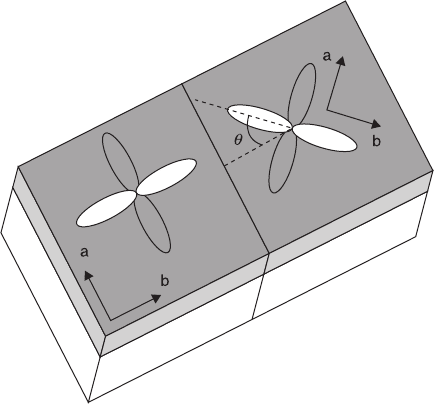
372 High-temperature superconductors
1
2
3
4
5
6
7
8
9
10
1
2
3
4
5
6
7
8
9
20
1
2
3
4
5
6
7
8
9
30
1
2
3
4
5
6
7
8
9
40
1
2
43X
© Woodhead Publishing Limited, 2011
9.2 Grain boundary Josephson junctions
9.2.1 Bicrystal grain boundary junctions
Most of the successful applications of HTS SQUIDs are realized by employing
YBa
2
Cu
3
O
7 – x
(YBCO) grain boundary (GB) junctions. Due to the short
coherence length in HTS, grain boundaries between otherwise crystalline films
present a weakened superconductivity and in certain conditions they show
Josephson effect. The simplest way to create a grain boundary is the bicrystal
technique where substrates of different crystallographic orientations are glued
together at high temperature. A YBCO film is then deposited on top of the
bicrystal. One can go from the crystallographic axis of one part of the film to those
of the other by considering a rotation angle θ around a specific axis. Tilt grain
boundaries (GBs) are obtained if the rotation is around an axis contained in the
plane of the boundary, twist if the axis is perpendicular to the boundary plane.
Figure 9.1 shows a sketch of an asymmetric θ [001] tilt grain boundary. It is also
possible to realize symmetric GBs. In this case the order parameter in both
electrodes are rotated by the same absolute angle but with opposite sign around
the specific axis of the grain boundary.
The bicrystal junctions used for SQUID applications are generally of this type
(with 0° <
θ
< 45°) and they exhibit current voltage characteristics reasonably
close to the resistively shunted junction (RSJ) model, provided the grain boundary
angle θ exceeds a critical value, about 10° for YBCO (Dimos et al., 1990).
9.1 Sketch of a bicrystal substrate with an asymmetric [001] tilt GB
and a YBCO film grown on top of it.
d-Wave YBCO dc SQUIDs 373
1
2
3
4
5
6
7
8
9
10
1
2
3
4
5
6
7
8
9
20
1
2
3
4
5
6
7
8
9
30
1
2
3
4
5
6
7
8
9
40
1
2
43X
© Woodhead Publishing Limited, 2011
For [001] tilt YBCO GB junctions the critical-current density j
c
decreases
exponentially with increasing grain boundary angle (Gross and Mayer, 1991;
Ivanov et al., 1991). This behavior can be explained in part by the d-wave pairing
symmetry of the order parameter (Sigrist and Rice, 1995) and in part by extrinsic
effects like the faceting of the grain boundary (Hilgenkamp et al., 1996); however,
it is likely that a further contribution can arise from an increase of the barrier
thickness with increasing grain boundary angle.
Most SQUIDs have been made on symmetric 24° or 36° bicrystals. Recently,
more complicated bicrystals with grain boundaries that are a combination of tilt
and twist have been used to realize SQUIDs with unconventional properties in
view of novel devices. In particular, 45° [001] tilt + 45° [100] tilt (or [010] twist)
have been investigated. The reason is twofold:
1 θ [001] grain boundaries usually show as RSJ current voltage characteristic with
no hysteresis. While this feature is desirable for many of the most successful
applications of SQUIDS, such as non destructive evaluation of structural
systems, e.g. aircrafts and bio sensing of brain and heart activities, high quality
factor SQUIDs with large hysteresis can give access to a regime where
macroscopic quantum effects are dominant. This is fundamental in view of the
possible application of HTS SQUIDs as two level systems or quantum bits
(qubits). In this respect, GB with 45° [100] tilt have proven to have a specific
resistance one order of magnitude higher compared with 45° [001] GB
(100 Ωµm
2
for 45° [100] compared to 0.1–10 Ωµm
2
for 45° [001] GB) (Lombardi
et al., 2006; Lindström et al., 2006) which leads to highly hysteretic junctions.
2 Because of the d-wave symmetry of the order parameter the Josephson effect
in 45° [001] grain boundaries presents a new phenomenology which can be
used to design novel devices. We refer to the existence of an unconventional
current-phase relation (CPR) where the tunneling is in the node of the d-wave
order parameter in one of the electrodes. This is the case of 45° [001] GB
where the a-b planes in one electrode are rotated 45° with respect to the other
(see Fig. 9.2).
From symmetry considerations, the first harmonics in the current-phase relation
(CPR) of supercurrent is suppressed, since the tunneling of Cooper pairs from a
lobe to a node of the order parameter is forbidden. Ideally, the supercurrent in this
geometry should contain only higher harmonics of the CPR, mainly the second
(proportional to sin2ϕ). However, in a real junction the presence of both faceting
and scattering at the grain boundary plane tends to re-establish the 1st harmonic
component (see Fig. 9.2). The interplay between the 1st (sin ϕ, 2π periodic) and
the 2nd (sin2ϕ, π periodic) harmonics has unique effects which strongly influence
the dynamics of Josephson junctions and SQUIDs (Löfwander et al., 2001). As
will be extensively discussed later, this unconventional current phase relation may
lead to a fundamental state that is double degenerate which can be used to realize
an HTS silent quantum bit.
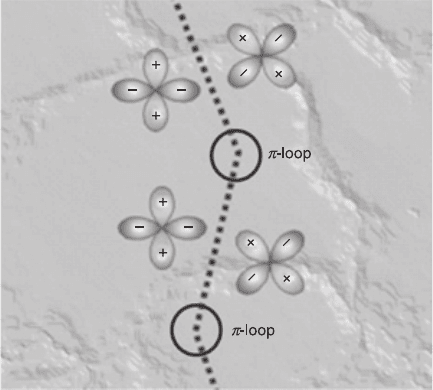
374 High-temperature superconductors
1
2
3
4
5
6
7
8
9
10
1
2
3
4
5
6
7
8
9
20
1
2
3
4
5
6
7
8
9
30
1
2
3
4
5
6
7
8
9
40
1
2
43X
© Woodhead Publishing Limited, 2011
In the beginning of the research on HTS SQUIDs, 45° [001] GBs were
considered not suitable for applications. For these GBs the combination of
tunnelling in the node in one electrode and the faceting of the grain boundary
line gives rise to unconventional magnetic field response, a huge scatter in the
junctions parameters and higher values of 1/f noise compared to 24° or 36°
bicrystals (attributed to the presence of π-loops (see Fig. 9.2)). Nowadays, instead,
HTS SQUIDs with grain boundaries characterized by 45° [001] tilt + 45° [100]
tilt fulfill the main requirement for novel application in the quantum limit.
9.2.2 Step-edge grain-boundary junctions
The step-edge grain-boundary junction (GBJ), which is also widely used, is based
on the fact that an epitaxially grown, c-axis YBCO film changes its orientation at
a steep step in the substrate. This technique, initially realized by Daley et al.
(1990), was subsequently refined by several groups (Herrmann et al., 1991, 1995;
Sun et al., 1993; Yi et al., 1996). Common substrate materials are perovskites
(001) SrTiO
3
and (001) LaAlO
3
. For such substrates the GB microstructure
strongly depends on the step profile. For a step angle α < 45° there will not be GB
formation, while for α ~ 45° GBs will be formed at the top and bottom edge and
along the step profile. Only on relatively steep steps, α > 50°, there will be the
formation of two 90° [100] tilt grain boundaries at the top and bottom edge of the
step (Jia et al., 1991). For large step angles (α
~ 70°) the two grain boundaries at
9.2 Schematic representation of a [001] YBCO 45° grain boundary.
It shows the orientation of the d-wave order parameter in the two
electrodes and considers the presence of faceting and π-loops.
d-Wave YBCO dc SQUIDs 375
1
2
3
4
5
6
7
8
9
10
1
2
3
4
5
6
7
8
9
20
1
2
3
4
5
6
7
8
9
30
1
2
3
4
5
6
7
8
9
40
1
2
43X
© Woodhead Publishing Limited, 2011
the top and bottom edge of the step have a quite different microstructure which
strongly depend on the exact morphology of the edges (Jia et al., 1992; Lombardi
et al., 1998). In this case it has been found that only one grain boundary (the top
one) is responsible for the Josephson transport in the junction. The substrate steps
are aligned along major cubic axes of the substrate, and are usually patterned by
standard e-beam lithography and Ar-ion milling. Often e-beam lithography in
combination with hard milling masks (like amorphous carbon) is used to get steep
and uniform steps. Clearly step-edge junctions can be placed at will on the
substrate. This advantage over the bicrystal technique enables the fabrication of
more complex circuits. Even for SQUIDs which require only one or two junctions,
this flexibility in layout can be important, for example for minimizing parasitic
inductances.
However the properties of step-edge junctions depend strongly on the
microstructure of the milled step and on the step height/film thickness ratio (that
has to be larger than 1 to avoid overgrowth) and on film-growth conditions, leading
to greater spreads in parameters than for bicrystal junctions. Moreover, the
unavoidable presence of two grain boundaries in series for moderately steep step
may cause problems in the SQUIDs response, if their critical currents are quite
close (like for step angles α > 50°).
Step-edge YBCO SQUIDs have also been successfully implemented on
poorly matched substrates like MgO. Here, for any step angle more than a few
degrees (~10) there will be a formation of two grain boundaries at the top and
bottom edge of the step of type θ [100] tilt, with θ~
α
.
Many state-of-the-art applications of HTS step-edge SQUIDs have been
realized, such as systems for nondestructive evaluation (Itozaki et al., 1996;
Wunderlich et al., 1998), magneto-cardiography (Weidel et al., 1997; Krey et al.,
1997), scanning SQUID microscopy (Larsson et al., 2001), and digital circuits
(McCambridge et al., 1997).
9.2.3 Biepitaxial grain boundary junctions
In the biepitaxial technique a seed layer is deposited and then patterned on top of
the substrate. The seed layer has the function to change the epitaxial relations
between the HTS film and the bare substrate. This technique was originally
developed by Char and co-workers (1991) by employing (100) STO and (100)
MgO film as seed layer. The YBCO c-axis film grows on the seed layer with the
a-b planes rotated by 45° with respect to the bare STO substrate; the resulting
GBs are type θ [001] tilt with θ the angle between the [001] in-plane direction of
the substrate and the edge of the seed layer. Since a step between the surface of the
substrate and the surface of the seedlayer is unavoidable the growth mechanisms
of the GBs are much more complicated compared to the bicrystal, and often less
reproducible. In the initial stage of this technique (in the early 1990s) only 45°
[001] tilt GBs were investigated. They showed the same phenomenology as
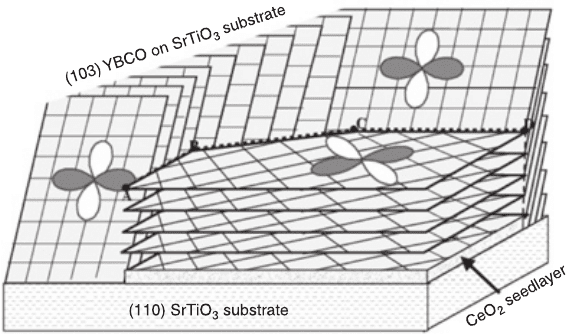
376 High-temperature superconductors
1
2
3
4
5
6
7
8
9
10
1
2
3
4
5
6
7
8
9
20
1
2
3
4
5
6
7
8
9
30
1
2
3
4
5
6
7
8
9
40
1
2
43X
© Woodhead Publishing Limited, 2011
45° [001] tilt bicrystal GBs with an enhanced 1/f noise (possibly due to more
defects due to the complex fabrication technique). For this reason this technique
was soon abandoned.
Since then there have been huge advances in the material science, structural
characterization techniques and fabrication methods. The use of substrates with
different orientations from the (001) and various seed layers has led to obtaining
complex grain boundaries which are a combination of θ [001] tilt and 45° [100]
tilt (or 45° [010] twist).
In Figure 9.3 a schematic picture of a biepitaxial sample employed in various
SQUID experiments is shown. Here (110) STO is used as substrate and (110)
CeO
2
as the seedlayer. The YBCO grows (103) oriented on the bare substrate and
(001) oriented on the seedlayer. Different GBs can be obtained by varying the
angle of the seedlayer edge with respect to the [001] in-plane direction of the
substrate. More details about this technique can be found in Miletto Granozio
(2003).
9.3 Dynamics of a current biased SQUID in the
presence of an unconventional current phase
relation
The dynamics of a current biased SQUID are described by two degrees of
freedom, namely the phase differences
ϕ
L
and
ϕ
R
across the two Josephson
Junctions (JJs) (see Fig. 9.4). Here a fictitious phase particle is moving in a two-
dimensional potential (Lefevre-Seguin, 1992) leading to various new phenomena
9.3 Sketch of a biepitaxial grain boundary with different interface
orientations. Reported planes are a-b planes on the (001) oriented side,
and a-b planes on the (103) oriented side.
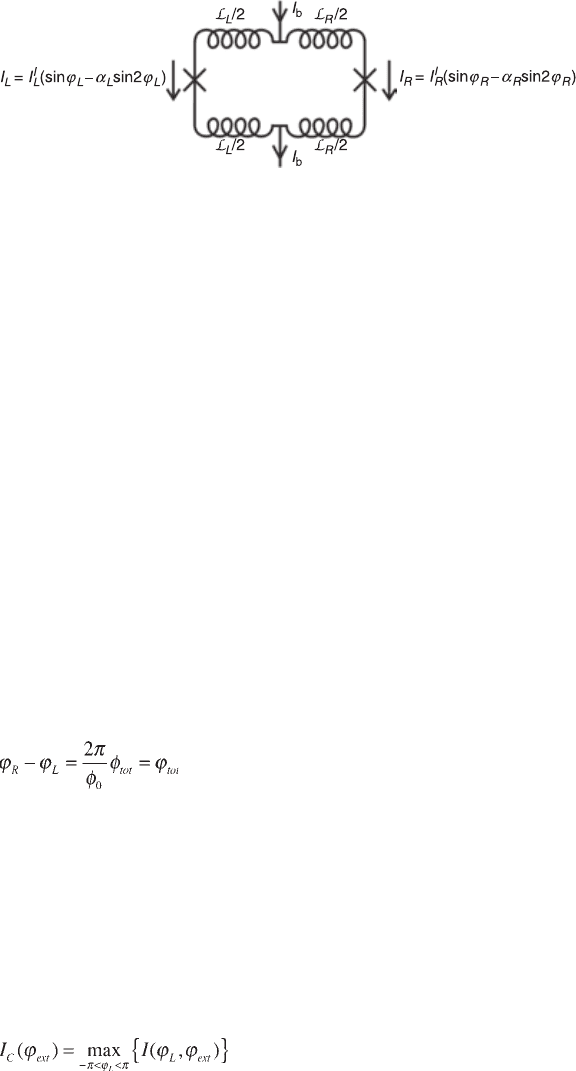
d-Wave YBCO dc SQUIDs 377
1
2
3
4
5
6
7
8
9
10
1
2
3
4
5
6
7
8
9
20
1
2
3
4
5
6
7
8
9
30
1
2
3
4
5
6
7
8
9
40
1
2
43X
© Woodhead Publishing Limited, 2011
compared to the dynamics of a single JJ which is described by a one-dimensional
potential. Here we assume that the magnetic area of the individual junctions is
much smaller than the loop area of the SQUID. This allows us to neglect the
magnetic field modulation of the junctions’ critical currents. In the limit of small
SQUID loop inductance the two phase differences across the two junctions are
strongly coupled. In this case the dynamics of the system can be reduced to a
phase particle moving in a one dimensional potential similar to a single JJ.
The expression for the total dc super-current through the SQUID, containing
JJs having a second harmonic component in the CPR, as a function of applied
external magnetic flux
φ
ext
is given by (Lindström et al., 2006):
I(
ϕ
L
,
ϕ
tot
) = I
I
L
{sin
ϕ
L
–
α
L
sin 2
ϕ
L
}
+ I
I
R
{sin(
ϕ
L
–
ϕ
tot
) –
α
R
sin 2(
ϕ
L
–
ϕ
tot
)} [9.1]
where the subscripts L and R denote the left and right arms of the SQUID,
respectively. Here
α
L,R
= I
II
L,R
/I
I
L,R
are the ratios between the second and the first
harmonic component in the CPR in the respective junctions. Moreover we made
use of the equality
[9.2]
deduced from the fluxoid quantization in the SQUID loop (Tinkham, 2004),
where
φ
0
= h/2e is the superconducting flux quantum. The total magnetic flux
threading the SQUID loop is given by the sum of the externally applied magnetic
flux
φ
ext
and the self-induced magnetic flux
φ
self
caused by the currents flowing
through the two SQUID arms,
φ
tot
=
φ
ext
+
φ
self
. Assuming that the SQUID loop
inductance L is equally divided between the two SQUID arms, the self-generated
magnetic flux can be expressed as
φ
self
= L (I
L
– I
R
)/2. The maximum critical
current of the SQUID as a function of external magnetic flux for negligible self-
field (
φ
tot
≈
φ
ext
) is given by
[9.3]
9.4 Schematic of a dc SQUID. The crosses represent the Josephson
junctions having unconventional CPRs. The SQUID loop inductance is
distributed between the left and right SQUID arms.
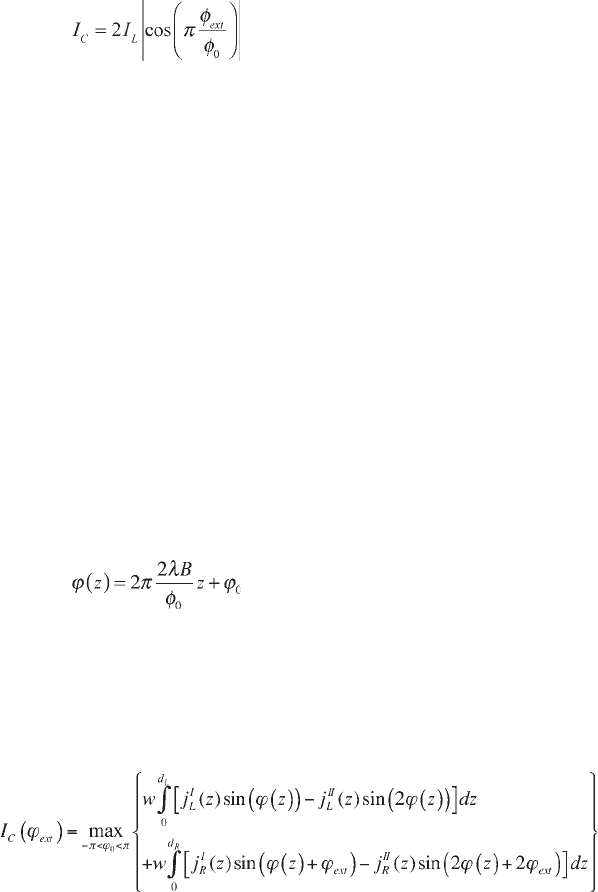
378 High-temperature superconductors
1
2
3
4
5
6
7
8
9
10
1
2
3
4
5
6
7
8
9
20
1
2
3
4
5
6
7
8
9
30
1
2
3
4
5
6
7
8
9
40
1
2
43X
© Woodhead Publishing Limited, 2011
For a SQUID with JJs having pure sinusoidal CPRs, equal values of the critical
current (I
L
= I
R
), and negligible loop inductance, the SQUID critical current can
be expressed as
[9.4]
which is depicted in Fig. 9.7(a).
For finite junction size, the situation becomes more complicated. Faceting of
the GB plays an important role and happens at two length scales: meandering
creates facets that are typically 100–200 nm long (see Fig. 9.2) and there is also
microfaceting which is related to the lattice structure and has a typical length scale
of 1–2 nm (Chan et al., 2003). Due to the d-wave symmetry the local properties
of the GB depend strongly on the misorientation angle (Mannhart and Chaudhari,
2001). An important consequence of the meandering is the presence of so-called
π
-facets in the GB. Ideally, the 0°–45° misorientation should result in a node–lobe
arrangement of the order parameter in the electrodes (see Fig. 9.1) but since
the GB meanders, the exact arrangement varies. In some of these facets the
arrangement will be, e.g., plus–plus and in some plus–minus. This means that the
phase difference across the GB due to the d-wave symmetry will be shifted by
π
in some places resulting in a negative Josephson current density. As a result the
critical current density across the junctions j
L,R
varies both in amplitude and sign
as we move along the GB.
Following the usual method of deriving the equation that governs the behavior
of a magnetically short junction in a perpendicular magnetic field B, we define the
phase difference along the grain boundary
[9.5]
Here the barrier thickness d of the junctions is assumed negligible compared to
the London penetration depth
λ
. Introducing j
I
L,R
(z), j
II
L,R
(z), the critical current
densities of the first and second harmonic components as we move along the GB
in the left and right SQUID arm, we can write the magnetic field dependence of
the critical current of a SQUID as (Lindström et al., 2006):
[9.6]
where w is the film/junction thickness and
ϕ
ext
= 2
π
BA/
φ
0
is the normalized
external magnetic flux threading the SQUID loop. The SQUID area is given by
A, and d
L,R
is the width of the left and right junction, respectively.
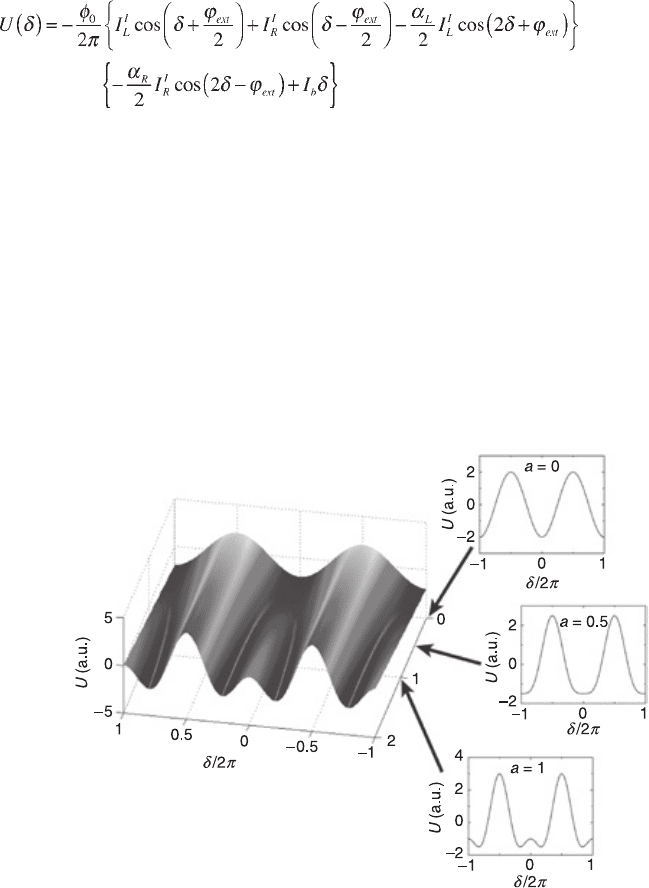
d-Wave YBCO dc SQUIDs 379
1
2
3
4
5
6
7
8
9
10
1
2
3
4
5
6
7
8
9
20
1
2
3
4
5
6
7
8
9
30
1
2
3
4
5
6
7
8
9
40
1
2
43X
© Woodhead Publishing Limited, 2011
For given values of I
I
L
, I
I
R
,
α
L
,
α
R
, and
ϕ
ext
the potential of the SQUID in the
approximation of a negligible magnetic area of the junctions and negligible
SQUID loop inductance L → 0 is given by
[9.7]
where
δ
= (
ϕ
L
+
ϕ
R
)/2. The particle mass is given by m
δ
= C(
φ
0
/2
π
)
2
with C the
capacitance of the junctions. The bias current I
b
determines the tilt of the washboard
potential. For
ϕ
ext
= 0 and I
I
L
= I
I
R
we show in Fig. 9.5 the calculated SQUID potential
as a function of the parameter a = (
α
L
+
α
R
)/2 and average phase difference
δ
at zero
external applied magnetic field according to equation [9.4]. The insets show the
SQUID potential for three different values of the parameter a. For a = 0 the potential
is single welled. In the case of a = 0.5 we clearly see a flattening in the minimum of
the well. The potential becomes double welled for a > 0.5 as shown in the lowest
inset. This dependence is the same as for a single junction (Tzalenchuk et al., 2003).
The double well potential can be used to realize a ‘silent’ quantum bit strongly
decoupled from the environment, as will be discussed later.
9.5 Calculated SQUID potential as a function of the parameter
a = (
α
L
+
α
R
)/2 and average phase difference
δ
at zero external applied
magnetic field and zero bias current. The insets show the SQUID
potential for three different values of the parameter a.
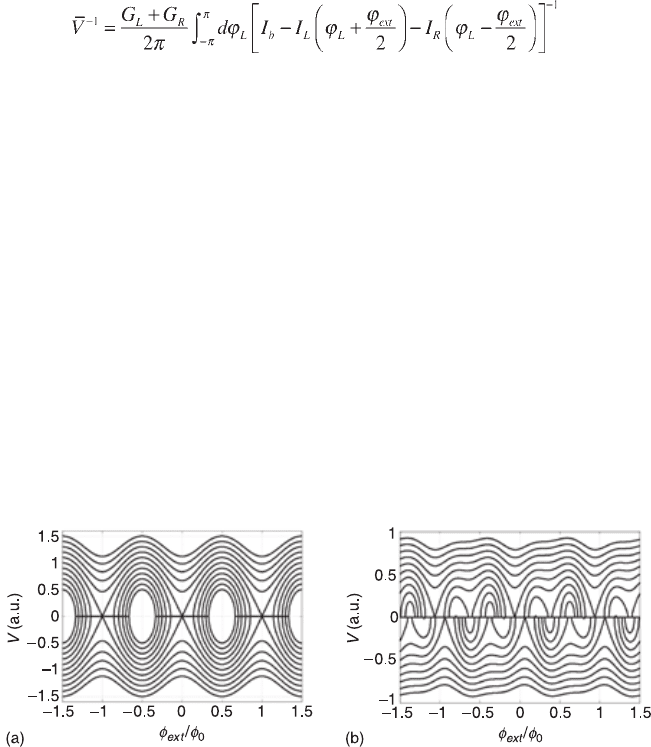
380 High-temperature superconductors
1
2
3
4
5
6
7
8
9
10
1
2
3
4
5
6
7
8
9
20
1
2
3
4
5
6
7
8
9
30
1
2
3
4
5
6
7
8
9
40
1
2
43X
© Woodhead Publishing Limited, 2011
When the bias current is ramped from I = 0 to I < I
C
, the SQUID is in the zero
voltage state in the absence of thermal or quantum fluctuations. At finite
temperature the junction may switch into a finite voltage state for a bias current
I < I
C
. This corresponds to the phase particle escaping from the well either by a
thermally activated process or by tunneling through the barrier potential (Martinis
et al., 1987). The time averaged voltage V
̅
across the SQUID in the resistive
regime can be approximated within the resistively shunted junction model
(Lindström et al., 2003) and assuming a negligible SQUID loop inductance:
[9.8]
Here G
L,R
are the normal conductances of the junctions. In Fig. 9.6 we plot the
voltage as a function of an externally applied magnetic flux at various bias currents
between I
C
max
/2 and 3I
C
max
/2 for two different SQUIDs, were I
C
max
= maxI
C
(
φ
ext
)
φ
0
/2 <
φ
ext
<
φ
0
/2. The SQUID having JJs with pure sinusoidal CPRs shows the
typical
φ
0
periodic voltage modulations, while, the SQUID having a second
harmonic component in the CPRs shows two distinct features: an offset in the
voltage vs. flux characteristic with respect to the polarity of the bias current and
an additional modulation superimposed to the
φ
0
periodic modulation.
9.4 Probing the second harmonic component in the
current phase relation by the magnetic field
response of the SQUID
There have been several reports on the detection of an unconventional CPR in
HTS systems. Most of the works refer to YBCO rf (Il’ichev et al., 2001) and dc
SQUIDs (Lindström et al., 2003) with proper order parameter orientation in the
9.6 Voltage vs. externally applied magnetic flux for two dc SQUIDs
with different ratios of the first and second harmonic components
in the CPRs. The parameters are: (a) I
I
L
= I
I
R
= 1.0 and
α
L
=
α
R
= 0;
(b) I
I
L
= 0.98, I
I
R
= 0.19,
α
L
= 0.13 and
α
R
= 1.0. The patterns are plotted
for I
b
/I
C
max
= 0.5 to I
b
/I
C
max
= 1.5.
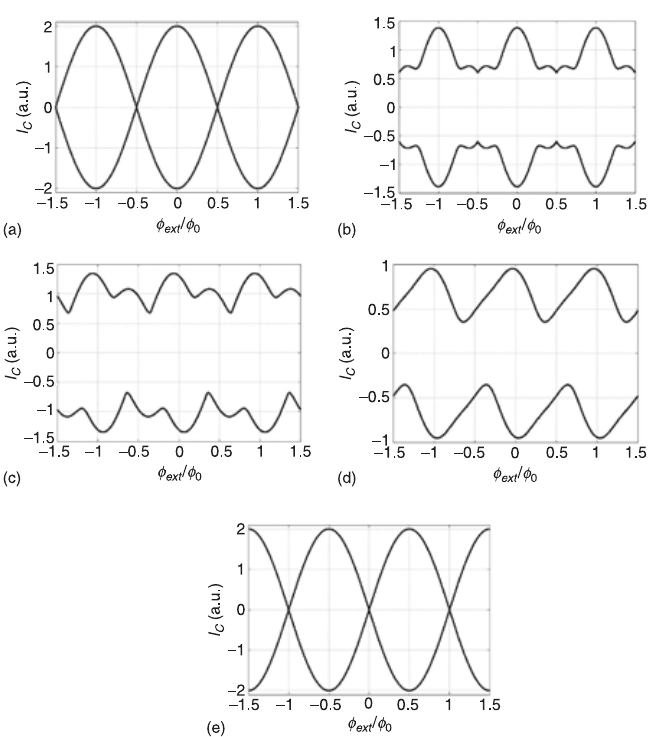
d-Wave YBCO dc SQUIDs 381
1
2
3
4
5
6
7
8
9
10
1
2
3
4
5
6
7
8
9
20
1
2
3
4
5
6
7
8
9
30
1
2
3
4
5
6
7
8
9
40
1
2
43X
© Woodhead Publishing Limited, 2011
electrodes. Because of the sin(2
ϕ
) term the SQUID response to an external
magnetic field is strongly modified compared to a SQUID with JJs having pure
sin
ϕ
CPRs. In the following we will focus only on the dc SQUID response upon
an admixture of second harmonic in the CPRs of the Josephson junctions. The
most striking demonstration of the second harmonic component in the CPR of the
JJs in a SQUID are intermediate maxima in the modulation pattern of the critical
current as a function of an externally applied magnetic field. In Fig. 9.7 we show
9.7 Calculated critical currents for five different dc SQUIDs. The
parameters are: (a) I
I
L
= I
I
R
= 1.0 and
α
L
=
α
R
= 0; (b) I
I
L
= I
I
R
= 0.5 and
α
L
=
α
R
= 0.6; (c) I
I
L
= 0.98, I
I
R
= 0.19,
α
L
= 0.13, and
α
R
= 1.0; (d) I
I
L
= 0.28,
I
I
R
= 0.47,
α
L
= 0.2, and
α
R
= 0.6; (e) I
L
= – I
R
1.0 and
α
L
=
α
R
= 0. The
minus sign corresponds to an additional
π
-phase shift in the CPR of the
right junction resulting in a typical
π
-SQUID modulation pattern.
